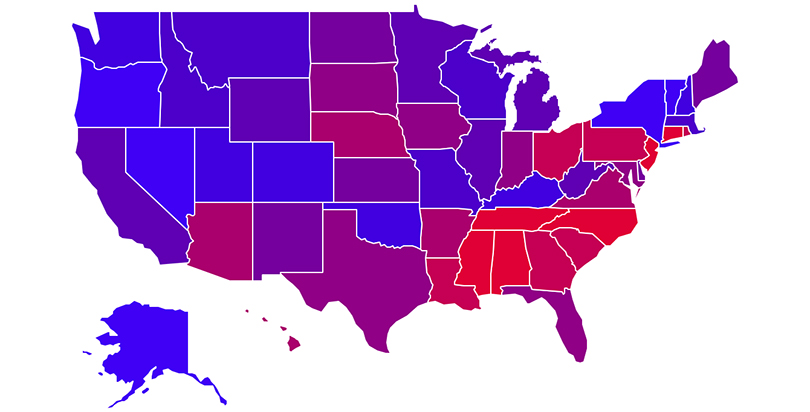Homeless students have long been considered an invisible population in American education policy discussions, but the new federal education law puts a renewed emphasis on identifying and serving them. In recent years, some states have focused on success for displaced youth. However, huge disparities still exist across the country, according to a new report by the Institute for Children, Poverty and Homelessness.
“Out of the Shadows: A State-by-State Ranking of Accountability for Homeless Students” uses five student participation indicators to “hold states accountable” on their ability to support and identify displaced children. In the institute’s rankings, which include all 50 states and Washington, D.C., Oregon and New York top the list, while Tennessee and Mississippi rank at the bottom.
“We see better-ranked states kind of in the West, and we see this curious cluster of low-ranked states in the South,” said Josef Kannegaard, a senior policy analyst at the institute. Among states that ranked highest in their analysis, he said, several “have recently undertaken new initiatives aimed at bridging the gap across different government agencies and also working in closer collaboration with local educators as well as with the shelters and other community-based organizations.”
Here are the five indicators the nonprofit used to rank each state, with its explanation of why each measure is significant:
- Percentage of homeless children enrolled in early Head Start or Head Start: States with a higher percentage of homeless children enrolled in Head Start are more likely to have partnerships among Head Start programs, government agencies, and local shelters to foster better access to services.
- Proportion of poor children enrolled in pre-kindergarten who are homeless: Homeless children may be underidentified or underenrolled in states where they make up a small percentage of kids in poverty.
- Percentage of extremely poor students in K-12 who are homeless: This measure, the group said, is its best proxy for highlighting areas where homeless students may be underidentified.
- Percentage of students identified as homeless and living “doubled up”: These kids, representing three-quarters of all homeless students, live temporarily with another family or household due to economic hardship. Recognizing the type of homelessness a student experiences, according to the report, helps ensure effective supports.
- Percentage of homeless students identified as having a disability: Homeless students are generally identified as disabled later than the general student population. This measure, according to the report, can help states ensure that they properly evaluate and refer students experiencing homelessness.
Based on these metrics, here’s a map showing how each state ranks. Included are state-by-state data on the Head Start and pre-K measures. Specific data for the three remaining indicators will be released in the coming weeks, Kannegaard said.
Roughly 1.3 million children attend K-12 schools in America. But that number nearly doubles when children of preschool age are included, said Ralph Nunez, the institute’s president and CEO.
“Homeless students miss school more often, repeat grades more often, and drop out more often than their housed peers,” Nunez said. “Unless we recognize and address their specific educational needs, many of today’s homeless students will become tomorrow’s homeless parents.”
The Every Student Succeeds Act, signed by then-President Barack Obama in 2015, requires schools to hire enough personnel to adequately educate homeless students, and states are required to allocate more federal money to serve their needs. For the first time, beginning next school year, the law will require states to report the graduation rates of homeless youth in the same way they do other vulnerable groups, such as the disabled and English language learners.
Kannegaard said the data presented in his report should serve as a “jumping-off point” to look more deeply at best practices that states have used to identify homeless students. Although current data allow researchers to analyze participation in education services among homeless youth, in the coming years they’ll be able to better analyze how students who are enrolled actually perform.
“It’s certainly very exciting, the type of numbers that are going to be coming out, particularly with regard to looking at more definitive outcomes like graduation or standardized test scores for homeless students,” Kannegaard said. “We won’t know more at least until the end of the school year, as more states adopt the now-mandated policies.”
Get stories like these delivered straight to your inbox. Sign up for The 74 Newsletter


;)
